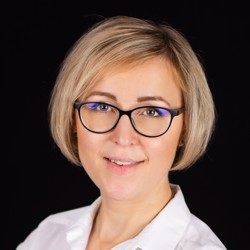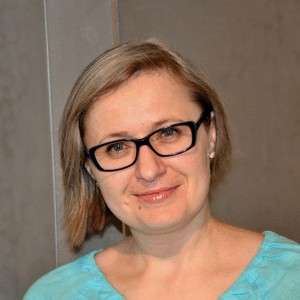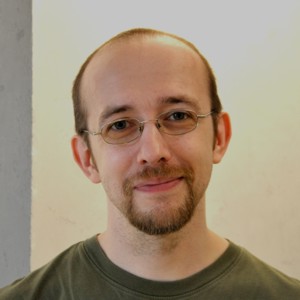
Project POWROTY
„Development of high quality InAlN - the road to strain-free nitride lasers”
Programme Description
The aim of the POWROTY/REINTEGRATION programme funded by Foundation for Polish Science is to improve the human potential in the R&D sector by financing innovative projects carried out by young doctors (postdocs) from all over the world, returning to scientific research after a break in R&D work, at research units or companies in Poland, working in the most innovative areas, with the involvement of a scientific partner, i.e. local or foreign research partner.
Project Goal
The project goal is to understand growth mechanism and develop a fabrication method of a homegenous high quality InAlN material, with composition: 17% In and 83% Al, to be used it in visible light (400-650 nm) emitting laser diodes. Huge advantage of such InAlN compostion is that it has the same lattice constant as GaN substrate and smaller refraction index. Thus it could provide optical mode confinement in laser structures without generation of any structural strain. So far no effective method has been developed for obtaining this material of sufficient quality to utilise it in commercial devices. This is what we want to change during our Project.
InAlN compound can be grown with uniform composition only if the In and Al atoms are able to diffuse on the crystal surface and incorporate in the right places. This is a challege because indium atoms are very weekly bonded with the crystal in opposite to aluminum atoms with high bond strength, but low mobility. Eventually people observed so called "honeycomb" microstructure caused by aluminium atoms clustering and preferential incorporation to crystal, surrounded by the areas with lower local Al content.
The InAlN layers and structures will be fabricated by plasma assisted molecular beam epitaxy (PAMBE) technology which does not involve hydrogen. Our goal is to understand the growth mechanism and find optimal conditions for high-quality InAlN. We will optimize the growth temperature, quantity and ratio of In, Al, N atoms delivered to the surface and crystallographic orientation of the substrate. To achieve uniform chemical composition of InAlN surfaces we will realise three approaches:
- We will carry out the growth on GaN substrates with narrow atomic terraces - then we will shorten the diffusion path of low mobility Al atoms and decrease the growth anisotropy.
- We will use very high nitrogen flux which will enable us to investigate growth conditions beyond the standard ones studied so far.
- We will use GaN substrates with low dislocations density to eliminate dislocation as a possible cause for the anisotropy in composition.
Project is based on many years' experience in growth of nitride semiconductors at Institute of High Pressure Physics PAS. Experimental research will be supported by scientists from Technical University of Madrid and theoretical physics group from Institute of Physics PAS. With the use of Monte-Carlo method for simulation of InAlN surface morphology we will better understand microscopic processes during epitaxy. Project's results will be tested on real LD structures that are to be manufactured in collaboration with TopGaN. We will compare 450 nm lasers with InAlN cladding and so far used AlGaN solution ones.
The main benefit from high quality InAlN replacing AlGaN claddings will be (a) improvement of optical parameters of laser beam and ridding of leakage of light into the substrate for edge emitting laser diodes and (b) a revolution in regarding commercial fabrication of vertical surface emitting lasers (VCSELs) - enabling of monolithic growing of laser structures.
A variety of nitride lasers applications is really wide. One of the greatest (and still growing in) importance are 2D and 3D image displays. Thanks to a very little laser dot, the beam can be easily formed. Colour contrast, dynamic range and operational reliability of laser displays are incomparably better than for previous projection systems that are based on Hg or Xe lamps. With the help of laser light one can cure polymers in photolitography. In medicine, e.g. in optogenetics, lasers are used for optical stimulation of the hearing nerve. Importatnt apllications are professional high-resolution printers, hi-tec sensors, optical data storage systems. In car industry, e.g. BMW includes LDs based lamps in their i8 model. The demand for quicker data exchange in waveguide telecommunication is supplied with nitride lasers technology, and so is development of Li-Fi and Internet of Things. Advantages of GaN based LDs are also: miniaturisation of devices, long lifetime, high thermal stability and durability in harsh conditions.
Results obtained throughout the Project can not only improve the optical parameters of laser diodes but also open up a path towards mass production of nitride VCSELs.
Research Team
Zespół badawczy projektu POWROTY tworzą eksperci w dziedzinie epitaksji z wiązek molekularnych MBE:
- dr inż. Marta Sawicka - kierownik projektu
- mgr Anna Feduniewicz
- mgr inż. Paweł Wolny
- inż. Natalia Fiuczek
Fiuczek
Publications
Project is carried out from 2018 to 2021
Project resulted in the following publications:
- Electrically pumped blue laser diodes with nanoporous bottom cladding By: M. Sawicka, G. Muziol, N.Fiuczek, M.Hajdel, M. Siekacz, A. Feduniewicz-Żmuda, K. Nowakowski-Szkudlarek, P. Wolny, M. Żak, H. Turski, C. Skierbiszewski.. Opt. Express 30, …. 2022
- Composition Inhomogeneity in Nonpolar (101̅0) and Semipolar (202̅1) InAlN Layers Grown by Plasma-Assisted Molecular Beam Epitaxy, M. Sawicka, J. Smalc-Koziorowska, M. Kryśko, N. Fiuczek, P. Wolny, A. Feduniewicz-Żmuda, K. Nowakowski-Szkudlarek, H. Turski, and C. Skierbiszewski, Crystal Growth & Design 21, 5223-5230 (2021).
- Revealing inhomogeneous Si incorporation into GaN at the nanometer scale by electrochemical etching, M. Sawicka, N. Fiuczek, H. Turski, G. Muziol, M. Siekacz, K. Nowakowski-Szkudlarek, A. Feduniewicz-Zmuda, P. Wolny, C. Skierbiszewski, NANOSCALE, Volume: 12, Issue: 10, Pages: 6137-6143, Published: MAR 14 2020 10.1039/c9nr10968d
- Role of high nitrogen flux in InAlN growth by plasma-assisted molecular beam epitaxy By: M. Sawicka, N. Fiuczek, P. Wolny, A. Feduniewicz-Żmuda, M. Siekacz, M. Kryśko, K. Nowakowski-Szkudlarek, J. Smalc-Koziorowska, S. Kret, Ž. Gačević, E. Calleja, C. Skierbiszewski, Journal of Crystal Growth, 544 125720 (2020), 10.1016/j.jcrysgro.2020.125720
- Vertical Integration of Nitride Laser Diodes and Light Emitting Diodes by Tunnel Junctions, M. Siekacz, G. Muziol, H. Turski, M. Hajdel, M. Żak, M. Chlipała, M. Sawicka, K. Nowakowski-Szkudlarek, A. Feduniewicz-Żmuda, J. Smalc-Koziorowska, S. Stańczyk, C. Skierbiszewski, Electronics, 9 1481 (2020) 10.3390/electronics9091481
- Impact of the substrate lattice constant on the emission properties of InGaN/GaN short-period superlattices grown by plasma assisted MBE, M. Siekacz, P. Wolny, T. Ernst, E. Grzanka, G. Staszczak, T. Suski, A. Feduniewicz-Żmuda, M. Sawicka, J. Moneta, M. Anikeeva, T. Schulz, M. Albrecht, and C. Skierbiszewski, Superlattices and Microstructures 133, 106209 Published: July 2019
- Composition Inhomogeneity in Nonpolar (101̅0) and Semipolar (202̅1) InAlN Layers Grown by Plasma-Assisted Molecular Beam Epitaxy, M. Sawicka, J. Smalc-Koziorowska, M. Kryśko, N. Fiuczek, P. Wolny, A. Feduniewicz-Żmuda, K. Nowakowski-Szkudlarek, H. Turski, and C. Skierbiszewski, Crystal Growth & Design 21, 5223-5230 (2021).
- Revealing inhomogeneous Si incorporation into GaN at the nanometer scale by electrochemical etching, M. Sawicka, N. Fiuczek, H. Turski, G. Muziol, M. Siekacz, K. Nowakowski-Szkudlarek, A. Feduniewicz-Zmuda, P. Wolny, C. Skierbiszewski, NANOSCALE, Volume: 12, Issue: 10, Pages: 6137-6143, Published: MAR 14 2020 10.1039/c9nr10968d
- Role of high nitrogen flux in InAlN growth by plasma-assisted molecular beam epitaxy By: M. Sawicka, N. Fiuczek, P. Wolny, A. Feduniewicz-Żmuda, M. Siekacz, M. Kryśko, K. Nowakowski-Szkudlarek, J. Smalc-Koziorowska, S. Kret, Ž. Gačević, E. Calleja, C. Skierbiszewski, Journal of Crystal Growth, 544 125720 (2020), 10.1016/j.jcrysgro.2020.125720
- Vertical Integration of Nitride Laser Diodes and Light Emitting Diodes by Tunnel Junctions, M. Siekacz, G. Muziol, H. Turski, M. Hajdel, M. Żak, M. Chlipała, M. Sawicka, K. Nowakowski-Szkudlarek, A. Feduniewicz-Żmuda, J. Smalc-Koziorowska, S. Stańczyk, C. Skierbiszewski, Electronics, 9 1481 (2020) 10.3390/electronics9091481
- Impact of the substrate lattice constant on the emission properties of InGaN/GaN short-period superlattices grown by plasma assisted MBE, M. Siekacz, P. Wolny, T. Ernst, E. Grzanka, G. Staszczak, T. Suski, A. Feduniewicz-Żmuda, M. Sawicka, J. Moneta, M. Anikeeva, T. Schulz, M. Albrecht, and C. Skierbiszewski, Superlattices and Microstructures 133, 106209 Published: July 2019
Cooperation in the Project
- Instytut Fizyki PAN - prof. dr hab. Magdalena Załuska-Kotur
- TopGaN Sp. z o.o. - prof. dr hab. Michał Leszczyński
- ISOM Universidad Politechnica de Madrid - Prof. Enrique Calleja, Dr Zarko Gacevic
Contact
tel. +48 22 876 0352
lab. +48 22 876 0324
email: sawicka@unipress.waw.pl


